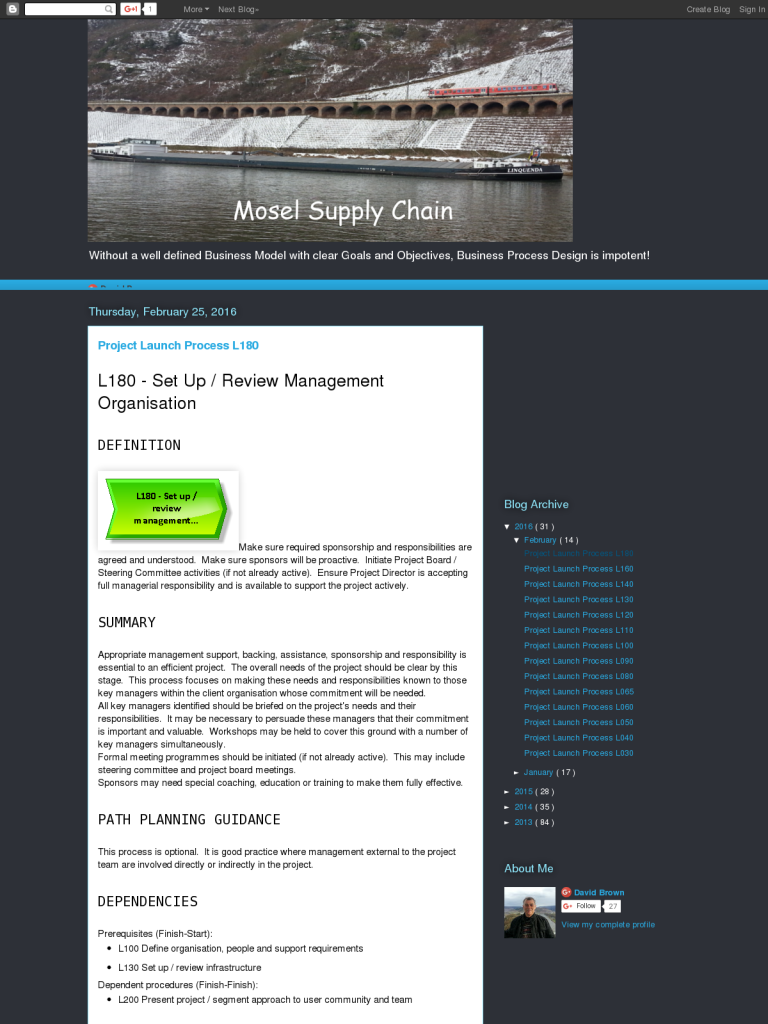Project Launch Process L180
Blog: Biz-Performance, David Brown
L180 – Set Up / Review Management Organisation
DEFINITION
SUMMARY
Appropriate management support, backing, assistance, sponsorship and responsibility is essential to an efficient project. The overall needs of the project should be clear by this stage. This process focuses on making these needs and responsibilities known to those key managers within the client organisation whose commitment will be needed.
All key managers identified should be briefed on the project’s needs and their responsibilities. It may be necessary to persuade these managers that their commitment is important and valuable. Workshops may be held to cover this ground with a number of key managers simultaneously.
Formal meeting programmes should be initiated (if not already active). This may include steering committee and project board meetings.
Sponsors may need special coaching, education or training to make them fully effective.
PATH PLANNING GUIDANCE
This process is optional. It is good practice where management external to the project team are involved directly or indirectly in the project.
DEPENDENCIES
Prerequisites (Finish-Start):
-
L100 Define organisation, people and support requirements
-
L130 Set up / review infrastructure
Dependent procedures (Finish-Finish):
-
L200 Present project / segment approach to user community and team
RECEIVABLES
-
Project constitution – scope, terms of reference, objectives
-
Definition of business needs and anticipated benefits
-
Project organigramme
-
Project job descriptions and charters
-
Segment plan
DELIVERABLES
-
Defined management structure and roles
-
Start up briefing meetings
TOOLS
• Managing Organizational Change methodology and materials
DETAILED DESCRIPTION OF TASKS
Roles and responsibilities
If the management structure and roles have not yet been fully defined and agreed this should now be finalised. Normally there will be a prime originating sponsor who is in a position to exert a guiding influence on other parts of the client organisation. If such a person has not been identified, it is valuable to do so.
The sponsor would normally be approached to cascade sponsorship through the other key management areas, particularly where the managers belong to other departments and are not directly connected with the project team. These “sustaining sponsors” will need to support the project in terms of motivation, the provision of suitable resources and political pressure where required. The message will normally be cascaded most effectively by the prime sponsor, but in some “political” environments it may prove more effective to use other methods. The best approach should be discussed and agreed with the project’s sponsor.
In many projects, the project will be under the formal control of a “Project Director”, who will typically be an influential manager from the client organisation. In most cases the Project Director would already be heavily involved with the project. If this is not the case, the Project Director will also need to be briefed in detail about the project.
It is normal practice to establish a formal management structure for the project as well as the informal sponsorship networks. This would typically comprise some form of steering committee or project board. The managers invited to attend this should be key decision makers for the main areas whose co-operation will be required to make a success of the project.
Their roles and responsibilities should be made clear, although, given that they will be in charge of the project, it may not be possible to be dictatorial in this area. Some further details of these roles and responsibilities may be found in Process L130 – Detail / revise staffing, team structure and organisation, or in the ITPM guide – chapter 3.
Following agreement with the project sponsor and the parties involved, the formal roles and responsibilities should be made known to all people involved with the project. It may be appropriate not to publicise details of informal sponsorship arrangements.
Start-up briefing meetings
All managers involved in the management or sponsorship of the project should be briefed about
-
the objectives, scope and terms of reference of the project
-
the business needs and anticipated benefits
-
the approach to be taken, including the high-level path plan
-
the project organisation and responsibilities
-
the anticipated timetable for their formal participation
-
the manner in which they are invited to participate
-
how to contribute comments, ideas and issues
-
how they can best support the objectives of the project.
This may be most effectively handled in a workshop session, although the prime sponsor and some other key participants will probably require individual briefing sessions. Where possible and effective, the main message should be presented by a key internal figure such as the prime sponsor or the chief executive. It is important to emphasize that it is the client organisation’s own project, under the organisation’s control, to further the organisation’s best interests. The role of the project team and external consultants should be presented as an enabling and facilitating role rather than a position of power and control.
Coaching, education and training
It may be appropriate to provide coaching, education and training for sponsors, sustaining sponsors and other key members of the client organisation’s management team. A number of education formats are available within the Managing Organisational Change (MOC) methodology.
Leave a Comment
You must be logged in to post a comment.








